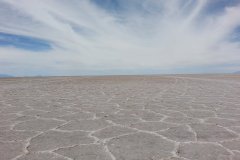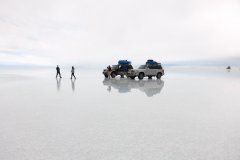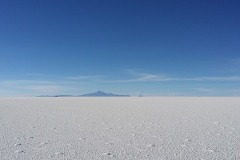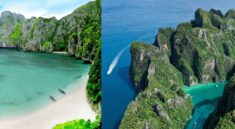This lake is situated in Bolivia which is a country in Central South America. This country has a varied terrain spanning Andes mountains, the Atacama desert and Amazon basin rainforest. Its administrative capital “La Paz” sits on the Andes’ Altiplano plateau with snow capped Mt. Illimani in the background. So, lets see what are the things that you should keep in mind before visiting this heavenly place.
Salar de Uyuni (salt water lake)
It is the largest salt water lake in the world having 10,582 square kilometers. It is also known as Salar de Tunupa. It is located in Southwest Bolivia. The salt present can reach up to 10 meters in thickness. It is a lucrative extraction site for salt and lithium- the element responsible for powering laptops, smart phones and electric cars.
How to get here?
Since this place is located at the crux of Bolivia, Chile and Argentina, so the length of your trip will depend where are you coming from. Generally, the tour originates from 3 main places:
- Uyuni, Bolivia
It is a small, dusty town packed with tourism agencies in Plaza Arce, its main square. Travelers can book tours through tour offices in La Paz or they can pursue the tour options in town itself after arriving Uyuni. Due to short distance between Uyuni and salt flats, easy day trips can be booked. Moreover, flights too can be booked through AMASZONAS and BOA. It will cost you around $130 for round trip taking one hour. Also, if you want to travel through buses, then you can do so by booking overnight buses from La Paz costing $30 to $40 each way. It will take around 10-12 hours. These buses can be booked with TRANS OMAR AND TODO TOURISMO. - San Pedro de Atacama, Chile
This usually takes 3-4 days and this tour is carried by agencies who drive travelers to the border before handing the tour over to a Bolivian operator. - Tupiza, Bolivia
This is the best starting point for those travelers coming form Argentina. A four day is recommended by tour operators, visiting Salar de Uyuni on the last day.
Best time to visit
Salar de Uyuni has two distinct seasons. One is the dry season and another one is the rainy season. The dry season starts from May and ends in November. During this season, temperatures are colder, the ground has hardened and travelers can drive across the stark white landscapes.

On the other hand, there is rainy season which starts from December and ends in April. In this season, tourists come to witness the Salar’s breathtaking mirror effect.
But due to excessive rainfall in December and January, tours may cancel. So, the high period to visit is from June to August. Also, there may be fluctuations in rate accordingly.
Choosing a tour
Travelers visiting Salar de Uyuni can choose between a shared tour or private tour. Shared tour is cheap and of standard nature. Usually, Spanish speaking guides are provided by shared tours. They do follow a rigid itinerary that generally do not respond to individual requests . In contrast to shared tours, private tours are higher prices and custom tailored. It provides English speaking guide, chef and a more comfortable vehicle. Moreover, private tours can be customized to a client’s liking thereby giving more itinerary to the traveler.
Things not to forget
- Travelers require a tourist visa ($160 for U.S citizens) as well as a Yellow Fever Vaccination Certificate to enter the country.
- Visitors may experience altitude sickness. So before visiting here, discuss various options for preventing and treating altitude sickness with your doctor.
- Ask your agency whether they carry an emergency radio and first aid kit.
- Avoid companies that offer rock bottom prices as they may not provide a good guide or working car which may endanger you.
Why is Salar de Uyuni famous?
Salar de Uyuni is famous for being the world’s largest salt flat, known for its stunning mirror-like surface, unique natural beauty, and its significance as a major tourist attraction and a source of valuable lithium reserves.
What is the world’s largest mirror?
The world’s largest natural mirror is often considered to be the Salar de Uyuni in Bolivia during the rainy season. When a thin layer of water covers the salt flat’s vast expanse, it reflects the sky, creating an illusion of infinity and making it resemble a giant mirror. This phenomenon has earned Salar de Uyuni its reputation as the “world’s largest mirror.”
Is Salar de Uyuni hot or cold?
Salar de Uyuni experiences extreme temperature variations, and whether it feels hot or cold largely depends on the time of day and the season.
During the day, especially in the summer months (December to March), it can get quite hot, with temperatures often reaching well above 30 degrees Celsius (86 degrees Fahrenheit). The reflective salt surface can intensify the heat and sunlight.
At night and during the winter months (June to August), temperatures can drop significantly, sometimes plunging below freezing. It can feel very cold, especially due to the high altitude of the area, which is around 3,656 meters (11,995 feet) above sea level.
So, Salar de Uyuni experiences both hot and cold conditions, with dramatic temperature fluctuations between day and night and across the seasons. Visitors are advised to be prepared for these temperature changes when planning a trip to the salt flat.
Who made Salar de Uyuni?
Salar de Uyuni is a natural geological formation, and it was not made by humans. It is the result of ancient geological processes and the transformation of prehistoric lakes. This expansive salt flat, located in Bolivia, is formed by the accumulation of salt deposits over thousands of years, creating a vast, unique, and stunning natural landscape. Human activities, such as salt harvesting and tourism, have interacted with this natural wonder, but its formation is entirely a product of natural geological forces.
What is the largest salt pan in the world?
The largest salt pan in the world is the Salar de Uyuni, located in southwest Bolivia. It covers an area of approximately 10,582 square kilometers (4,086 square miles) and is renowned for its vast, pristine salt crust, making it the largest and most famous salt flat globally.
Why is the salt flat like a mirror?
The salt flat at Salar de Uyuni can resemble a mirror during the rainy season due to its unique properties. When a thin layer of water accumulates on the flat’s flat and smooth surface, it creates a nearly perfect reflective surface. This phenomenon occurs because the water forms a shallow, temporary “lake” that perfectly mirrors the sky above, giving the illusion of an infinite and flawless mirror. This captivating effect is a major draw for photographers and tourists, making Salar de Uyuni famous for its mirror-like appearance.
Where is mirror of the sky?
The term “Mirror of the Sky” often refers to the Salar de Uyuni in Bolivia. During the rainy season, when a thin layer of water covers the salt flat’s vast expanse, it creates a near-perfect reflective surface that mirrors the sky above. This phenomenon gives the illusion of an endless, reflective “sky mirror,” which is why Salar de Uyuni is sometimes referred to as the “Mirror of the Sky.”
How does NASA use Salar de Uyuni?
NASA uses Salar de Uyuni primarily for satellite calibration and testing instruments intended for planetary missions. The vast, flat, and reflective surface of the salt flat helps calibrate Earth-observing satellites and simulate extraterrestrial environments for instrument testing.
Do people live in Salar de Uyuni?
People do live near Salar de Uyuni, but the salt flat itself is not a permanent residential area. There are several small towns and communities in the vicinity of the salt flat where local residents engage in activities such as salt harvesting, tourism, and agriculture. The largest nearby town is Uyuni, which serves as a gateway for tourists visiting the salt flat. While there may be temporary facilities for tourists and salt workers on the salt flat, it is not a place where permanent residential communities are established due to the harsh and inhospitable conditions, especially during the rainy season when it may be covered with water.
Can you eat the salt from Salar de Uyuni?
Yes, the salt from Salar de Uyuni is safe to eat, and it is used for both domestic consumption and commercial purposes. The salt flat is a significant source of salt production in Bolivia, and the salt is harvested, processed, and sold for various uses, including as table salt. However, before consuming salt from any source, it’s important to ensure that it has been properly processed and is suitable for consumption. Salt harvested from Salar de Uyuni typically goes through processing to remove impurities and ensure it meets quality standards for human consumption. So, while you can eat the salt from Salar de Uyuni, it’s best to purchase it from reputable sources to ensure its safety and quality.








